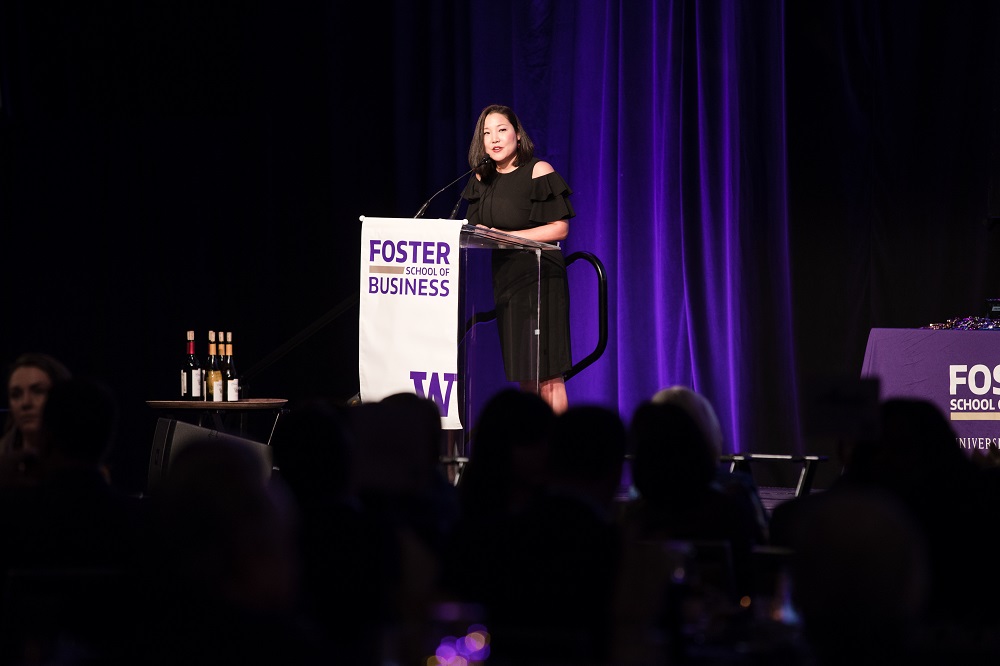BLC 2019: Crystal Farh challenges assumptions on team leadership
 The UW Foster School’s 28th annual Business Leadership Celebration featured a quintet of the school’s most-decorated faculty giving TED-style talks on different “Facets of Leadership.”
The UW Foster School’s 28th annual Business Leadership Celebration featured a quintet of the school’s most-decorated faculty giving TED-style talks on different “Facets of Leadership.”
Crystal Farh, an associate professor of management, Michael G. Foster Endowed Fellow and recipient of the 2019 PACCAR Award for Excellence in Teaching, challenged assumptions on team leadership, and what makes the most effective team.
Here is the text of Farh’s lecture:
What is an effective team?
Is it the one that scores the most goals? The one that passes the most? The one that is cohesive and exudes the most positivity?
I know how I would have answered this question years ago: It’s the team that gets the job done in as little time as possible. That’s what makes an effective team.
My thinking on this changed when I taught an experiential course on teams and leadership. In this course, teams of business undergrads were led by MBA students to compete on a series of strategy simulations.
If you’re familiar with the game “Battleship,” you’re on the right track. In essence, each member of the team is given unique clues and information that, if correctly pieced together with clues from other members, allows the team to locate and shoot down the opposing team’s high value targets and score the most points in a limited amount of time.
Importantly, each team was led by an MBA student, who—as the team leader—worked alongside the members to devise strategies and determine which strategies were ultimately implemented.
At the end of the course, the teams were ranked according to the total number of points they scored across all four simulations—which, by the way, got harder and harder as they went. As you can imagine, the scores were quite varied. But I noticed that there were two teams at the top who scored similarly. Team A scored 28 points, and Team B scored 30 points. It was easy to conclude that while both teams were effective, Team B takes the crown.
Cognitive dissonance
But then I went back to look at the cognitive ability profiles of the members in these teams, and what I found intrigued me.
Team A, it turns out, was a team of “Average Joes”—quite literally—with cognitive ability scores right around the population mean. Team B, on the other hand, was above average in cognitive ability. If we extrapolated simply from each team’s cognitive ability profiles, I wouldn’t have expected above average performance from Team A, a team with average cognitive ability.
Something happened that enabled that team of ordinary people to produce extraordinary performance.
We know from research that team performance is a function of at least two things. First, it’s a function of performance potential, which in this case, can be represented by the cognitive abilities of the members in the team. Second, it’s a function of how well members coordinate and collaborate with each other. This second component is critical. If members fail to share what they know with the rest of the team, or fail to use the clues they receive from others to inform their own actions; if disagreements among members escalate into a battle of winners and losers; if members keep silent about their ideas for improvement or look the other way when problems emerge; no matter how talented the team—potential won’t translate into performance. In fact, you’ll get less actual performance than the potential of the team.
And let’s be honest: we’ve all seen this before. And if you’ve experienced it, it’s soul-crushing.
But if members recognize that what the team is doing matters; if members are given the freedom to determine how their unique personalities, talents, and experiences can benefit the team; if members believe their contributions are valued and see that those contributions move the needle in a positive direction; if members have confidence that they will not be embarrassed, rejected, or excluded for showing weakness, making a mistake, or challenging the status quo—then you get actively engaged members who are looking for every opportunity to better themselves, better each other, and ultimately, better the team.
You get a team whose actual performance not only makes good on its potential but exceeds it. When we see this happen—and when we’re lucky enough to have been a part of it, it’s magical.
How to exceed expectations
Let me add one additional detail. Remember Team A, that team with average potential but above average performance? Well, I went back and looked at the leader’s cognitive ability score. And it turns out, he was average too.
Team B’s leader, on the other hand, boasted one of the highest scores in the class. And guess what? He did all the work. The members of his team had a lot to offer. But, in the shadow of a highly capable leader who clearly knew best, the members stuck to their assigned roles. They fed what they knew up to the leader, the leader fed down the strategy, and the members made it happen. And for the most part, this worked because the leader was a mastermind.
But Team A’s leader told the team plainly that he didn’t have a good grasp of the game. He told them he was depending on them to learn and master their roles, and that he would learn alongside of them. That even though he was the “team leader,” they had as much responsibility to lead the team as he did.
Most importantly, he told them that their potential to succeed was not a fixed point, but instead a point that, through effort and fearless trial and error, could move upward along a learning curve—and so, too, would their team’s performance.
And so the members of Team A checked each other’s work. They questioned each other’s assumptions. They spoke up and asked for help, without fear of being penalized for not knowing. When something went wrong, they doubled down on figuring out why it happened, not who was to blame. They figured out increasingly better ways of accomplishing their own roles as well as others’. Sometimes, just by the way people were acting, you couldn’t tell who was the leader and who was a member. Everyone had ownership. Everyone had a voice.
In a nutshell, Team B’s leader led followers to high performance. But Team A’s leader empowered followers to become leaders.
Redefining effectiveness
So, was it a team of Average Joes in the end? Yes, but only on paper, only where they started as individuals. In the end, even though they weren’t the highest scoring team, in my mind, they were the most effective because of the positive delta they put between how they should have performed and how they ultimately did perform.
I leave you with three questions to ask yourself:
- Is your team effective? Is your team’s performance less than, commensurate with, or above its performance potential?
- As a team leader, what can you do to increase that delta?
- What are some things that threaten that delta? As a team leader, what can you do to neutralize those threats?

